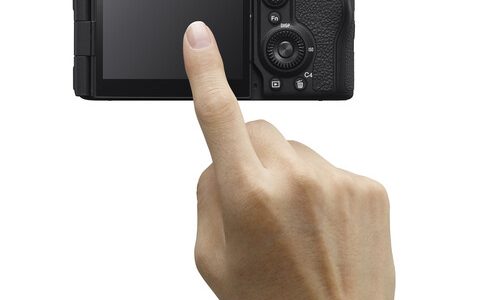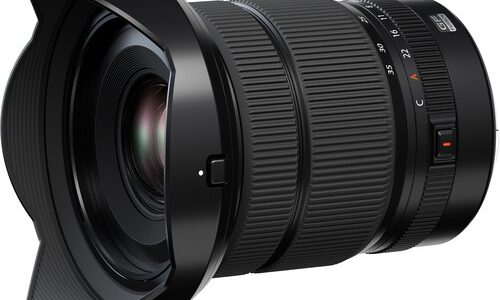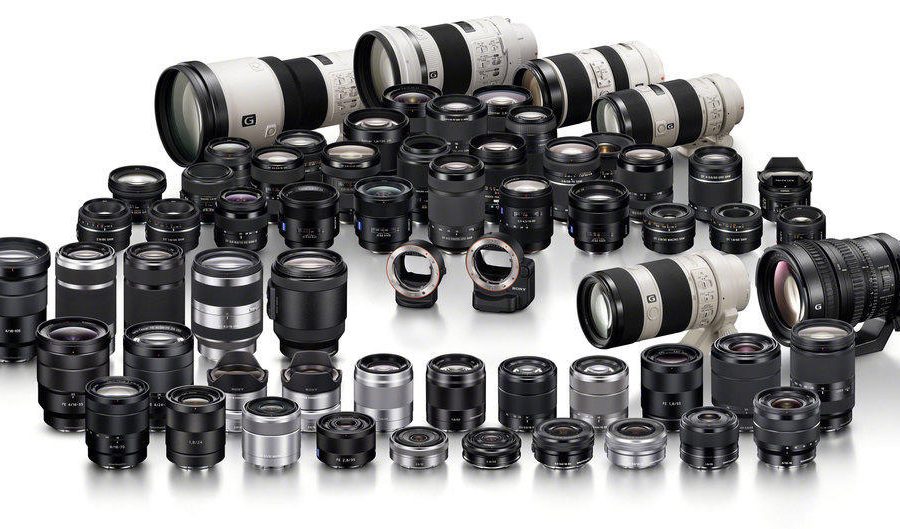

Sony:
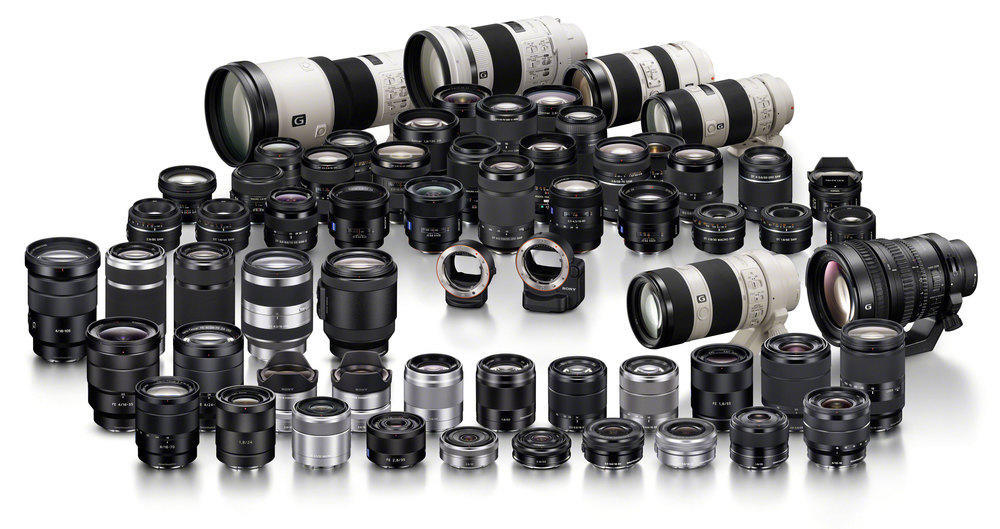
A Sony E-mount lens family portrait
Beyond question, the mirrorless market leader as of July, 2019, Sony also manufactures image sensors for most of their competitors. Sony has been in the mirrorless camera business since 2010, and their unofficial motto has always been “how much sensor can we stuff in there”. The early Sony mirrorless cameras were APS-C, and the lens lineup was sorely neglected. 2011’s NEX-7 introduced the first generation of the Sony 24 MP APS-C sensor that has been refreshed multiple times as it has been featured in numerous cameras from Nikon, Pentax and Fujifilm as well as Sony themselves.
As far as Sony’s own cameras are concerned the breakthrough came in late 2013, when they released the A7 and A7r, the first mainstream full-frame mirrorless cameras. At first, it looked like Sony’s full-frame line might look like their APS-C predecessors – plenty of bodies, but very few lenses, and the early full-frame lenses were uninspiring. To Sony’s enormous credit, they have released a comprehensive lens lineup in the past five years or so, including many good lenses and some outstanding ones. They don’t have as many exotics as Canon’s or Nikon’s DSLR lineups, and the quality of the lenses isn’t quite as consistent as Fujifilm’s APS-C lineup. Unless you need a tilt/shift lens, a telephoto over 600mm, a fisheye, a macro lens over 100mm or (inexplicably) a 300mm f2.8 lens, there’s at least one Sony lens for every need. There are often multiple options, and the best of them, including the high-end G-Master series, are excellent.
As far as full-frame bodies are concerned, if you can’t find a Sony that meets your needs, you can’t find a camera that meets your needs. Their interface is sometimes controversial, as is their weather sealing, but Sony offers the cheapest mirrorless body (and kit) on the market in the older A7 II ($898 for the body, $998 with a serviceable, if not ideal 28-70mm lens). They offer the cheapest high-resolution body, with an older A7r II for $1498, although the 24-105mm f4 lens you might want with it if you like standard-range zooms adds $1198 (either of Sony’s less expensive standard zooms will hold a high-resolution body back). Many of Sony’s or Sigma’s excellent prime lenses would be another good option. Sony offers the highest-resolution mirrorless body (other than the medium-format Fujifilm GFX 100) on the market, in the A7r IV. All Sony full-frame bodies currently sold new feature in-body image stabilization, and quite a few zoom lenses add lens stabilization as well.
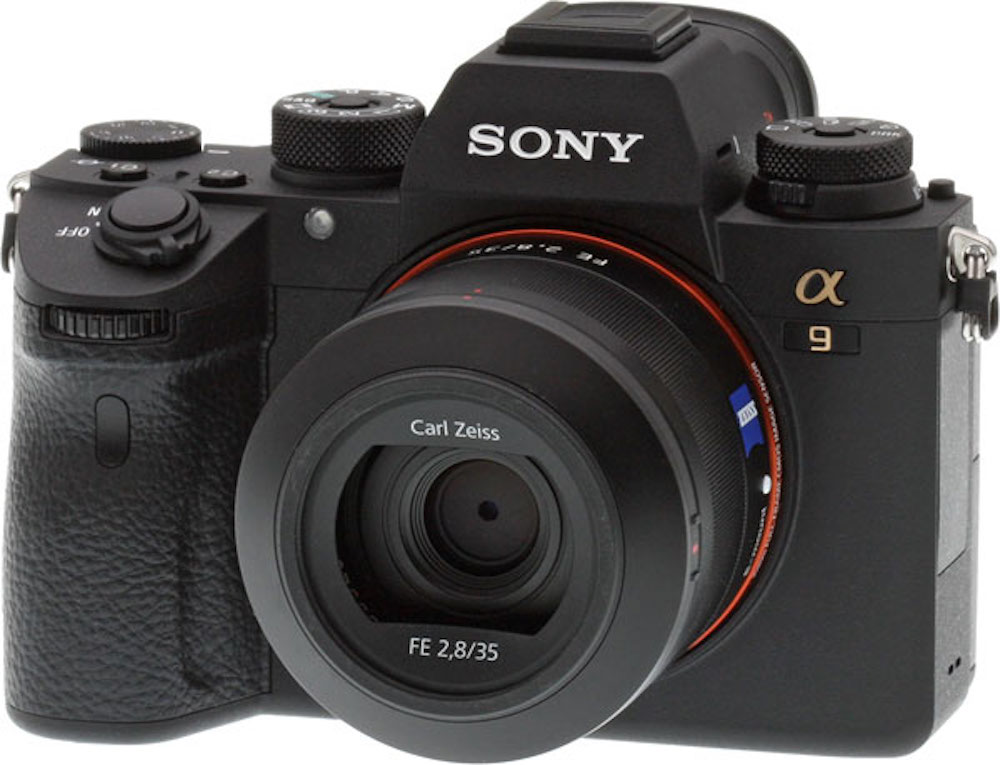
A very fast Sony A9 – why it’s got a 35mm f2.8 lens on it is a mystery to me
Their A9 is one of the two fastest cameras in the mirrorless world, and it is competitive with Nikon’s D5 and Canon’s EOS 1Dx II, the fastest DSLRs. While everybody else is releasing the first generation of their full-frame mirrorless bodies, Sony’s range from the second to the fourth generation. They have released 10 full-frame mirrorless cameras since 2013, and they have learned from each one. Their video-centered bodies are getting long in the tooth, with features and image quality eclipsed by Panasonic and increasingly by both Nikon and Fujifilm as well. On the other hand, the Sony E-mount is shared with many of Sony’s professional video cameras, providing excellent lens-sharing opportunities between stills and video. It is rumored that Sony still has a couple of bodies to release this fall – what will they be? A new video body? An even faster A9?
What are the reasons not to choose Sony? Their interface is often criticized as a computer with a sensor instead of a “real camera”. Things have improved in the past generation or two, but the most recent Sonys I have handled still don’t feel as “camera-ish” as, say, a Nikon or a Fujifilm. The A7r IV looks like the best Sony yet to handle, and I am very interested in trying a review sample. Their weather sealing lags well behind Olympus, Pentax, Nikon and Fujifilm – again, the A7r IV is supposed to have significant improvements.
While their lens lineup has improved rapidly, both in completeness and in average quality, there are still holes (where’s the 300mm f2.8 G-Master?) and a few weak lenses in prominent places (the only “standard zooms” that are worthy of the high-resolution bodies are the big, expensive 24-70 f2.8 G-Master and possibly the 24-105 f4). They have relatively weak 24-70mm f3.5-5.6 and 24-70mm f4 lenses that were introduced with the very first A7 bodies, and are in dire need of an update (or they could update the 24-70 f4 and discontinue the “cheapie” 28-70 f3.5-5.6). Nikon, Fujifilm and Olympus all have highly portable “standard zooms” that perform very well on their systems. I personally find a good 24-70 f4 or equivalent to be a very useful lens, especially when backpacking.
If there is no Sony lens for your application, you can adapt a lens. Canon lens adapters are easily found, and many preserve autofocus and other electronic communication. There are also Nikon adapters that provide electronic communication, although they are not as common. Manual adapters (no autofocus, substantial loss of exposure functionality) exist for most full-frame lenses. These adapters are made by small third-party companies, not by Sony, Canon or Nikon, and electronic adapters are trying to translate protocols that the adapter manufacturer has probably reverse engineered on the fly – it’s not going to be as bulletproof as a Canon DSLR lens to Canon mirrorless adapter made by Canon, nor a Nikon DSLR to Nikon mirrorless adapter made by Nikon!
Many older full-frame Sony bodies, including a few that are still sold, used a very small battery with terrible battery life. This has been fixed in recent years, and the newer battery lasts longer than anything else in the mirrorless world. Sony makes their own line of flashes, and most third-party flash makers support Sony.
Compared to the newer mirrorless mounts, the Sony FE mount is showing its age and its heritage. It was originally built for Sony’s APS-C cameras, and the dimensions allowed extremely compact cameras. The mount diameter is significantly smaller than Nikon’s and Canon’s native full-frame mirrorless mounts. There are optical design disadvantages to a narrow mount, especially for very wide or very fast lenses, and some of Nikon’s very compact lenses or Canon’s speed demons may be hard to equal on an FE mount.
Sony also makes a number of variations on the theme of an APS-C body, and a set of mostly undistinguished lenses to go with them. The bodies are largely older designs, and only the expensive a6500 has in-body image stabilization. With only a few decent lenses that aren’t shared with the full-frame bodies (a very compact 10-18mm f4 is one of the better ones), there really isn’t much reason to buy an APS-C E-mount body. Most of the weight savings offered by APS-C are in the lenses while most of the good lenses in the Sony system are full-frame anyway.
Some photographers buy an inexpensive a6000 body and tuck it in a corner of their pack as a backup to a full-frame Sony system. If their primary body breaks, their lenses get longer and their battery life gets shorter, but they still have something to shoot with (with an excellent 24 MP sensor). A full-frame A7 II is almost cheap enough to use in the same way, and it preserves lens focal lengths, plus it offers in-body image stabilization and some rudimentary weather sealing (the a6000 is completely unsealed and unstabilized). Unfortunately, it still uses the tiny batteries from the APS-C bodies instead of the more robust batteries of the newer full-frame models.
Fujifilm:

Some X-mount bodies and lenses (not the complete collection)
Fujifilm has been in the mirrorless business nearly as long as Sony, having released the X-Pro 1 and the original three prime lenses (a 18, 35, 60 mm trio that replicated the classic rangefinder focal lengths of 28, 50, 90mm) in early 2012, and their unofficial motto has been “we go our own way”. Fujifilm’s X-Pro 1 (and the slightly earlier, fixed-lens X100) were the cameras that started the “retro” design trend – and Fujifilm is still better at designing cameras that look like they were made in 1959 but perform at 2019 levels than anyone else.
Their bodies, lenses and mount were always designed for APS-C only, allowing them to realize significant weight savings compared to full-frame systems. The Fujifilm X system is the only comprehensive lineup of APS-C dedicated lenses on the market. Even Canon’s and Nikon’s APS-C DSLR systems rely heavily on larger full-frame lenses for less usual focal lengths and higher quality. The quality of the Fujinon lenses is excellent, and remarkably consistent across the line (not only are there very few duds, Fujifilm is nice enough to mark most of them on the outside of the lens – they say “Fujinon XC” instead of “Fujinon XF”). All X-series bodies use standard Sony sensors (16 MP in several early bodies, 24 MP in many more recent models, and a new 26 MP version in a couple of cameras released in the last year) – but Fujifilm puts their own, somewhat unusual color filter on the sensor.

The size, weight and durability of the Fujifilm X-T2 make it an excellent choice in the backcountry – Mount Adams through the mist
The X-Trans filter probably improves image quality slightly over the same sensor with a standard Bayer color filter. In most side-by-side tests, the Fuji comes out slightly ahead – but it also tends to have a better lens than whatever it’s tested against. Unfortunately, the X-Trans filter confuses some raw converters. Older versions of most converters are terrible, especially anything made by Adobe before they went subscription-only. Recent Adobe converters are much better, and Capture One and several other converters do an excellent job. A few manufacturers of raw converters, most notably DxO, simply throw up their hands and refuse to support X-Trans cameras at all.
There are actually a couple of low-end X-mount bodies which barely reach Western markets, but have Bayer sensors. It would be possible to test the same lens on one of those bodies and an X-Trans body, assuming the sensor is the same apart from the filtration. The only such test I can find online uses a low-end XC lens on both bodies – the “right” way would be to use the best possible lens on both.

While the California desert is dusty and rocky, the X-T2 I used to take this image on a monthlong hike in 2017 still works today
Fujifilm’s advantages are size, weight, ruggedness, design, color quality and, perhaps most importantly, the lens lineup. The cameras themselves are somewhat lighter than full-frame equivalents, and many of the lenses are substantially lighter. The higher-end bodies are quite rugged and well sealed against dust and light rain. While color is highly subjective, Fujifilm color on out of camera JPEGs is well-liked in general. Fujifilm’s lens lineup runs from 8mm to 400mm (12mm to 600 mm in full-frame equivalent terms), and almost all of them are very good or better, with quite a few exceptional lenses in the mix. The only weakness is image stabilization – only the (somewhat unusual) X-H1 body features in-body stabilization, and, while most of the zoom lenses are stabilized in the lens, only a couple of the primes are.
In the most used range from 15mm to 200mm, there will often be a choice of a couple of primes plus several zooms that cover a given focal length. 35mm is close to a normal focal length, and may be covered by more lenses than any other single focal length (35mm f1.4 and f2 primes, plus no less than six zooms ranging from a $200 lens kitted with the least expensive cameras to a top-end 16-55mm f2.8 that competes with the best 24-70 f2.8 lenses in full-frame systems).

A Fujinon 200mm f2.0 – it’s about the same size and weight as the 300mm f2.8 lens it’s equivalent to.
Because of the smaller sensor, shallow depth of field requires an aperture one stop faster than for the same field of view on a full-frame camera. Because lenses are easier to build for APS-C, many Fujifilm lenses actually are the requisite stop faster than their closest full-frame equivalents. Fujifilm makes a 200mm f2.0 lens, which has a similar field of view to a 300mm lens on a full-frame body. Since it’s a stop faster, it also has very similar minimum depth of field. Another important case where the extra stop is available is in portrait lenses. Fujifilm’s 56mm f1.2 is equivalent to an 85mm f1.8, in field of view and also in depth of field. Some full-frame systems include 85mm f1.4 lenses which offer half a stop more isolation – but they are at least twice the weight and cost of the Fujinon. The Fujinon lenses tend to perform well wide open or close to it – what good is a lens that offers slightly more subject isolation if it performs best stopped down? The 16-55mm f2.8 and 50-140mm f2.8 zooms are roughly equivalent (in size, weight, cost and minimum depth of field) to 24-70mm and 70-200mm f4 zooms in full-frame systems, although there are no heavier, more expensive f2.0 zooms to offer the final stop of subject isolation of an f2.8 zoom used wide open on a full-frame body. The 16-55 and 50-140 are both excellent wide open, minimizing the disadvantage.

The Fujinon 100-400 is slow, but there was plenty of light, and it doesn’t hurt that orcas are curious…
The few weaknesses in the lens line are mostly exotic lenses – there is no Fujifilm fisheye, although there are a couple of inexpensive manual-focus fisheyes in X-mount. There is no telephoto prime above the 200mm f2.0 – the longer range is covered exclusively by a sharp, but relatively slow 100-400mm zoom. There are no tilt/shift lenses.
Accessories other than lenses were a problem area until quite recently, but the situation is improving. Fujifilm continues to use the NP-W126 battery originally released in 2012, or a close relative, the NP-W 126s, which were barely adequate for the X-Pro 1 and its small prime lenses. Powering in-body image stabilization on the X-H1, high-end video on several models and focusing larger zoom lenses has taken its toll, and the tiny battery is no longer adequate. Carry a pocket full of them and consider using a multi-battery grip on models that support it.
Until 2017, the only dedicated flashes available for Fujifilm were a couple of low-end models that were basically overpriced variants of cheap Sunpak flashes. Fujifilm’s own EF-500 came out about the same time as a variety of third-party options. At this time, there are a wide variety of flash options ranging from inexpensive to Profoto’s AirTTL system. Rental houses may still not stock Fujifilm options as widely as Canon, Nikon or Sony.
The biggest disadvantage of the Fujifilm X system is that there is no path to a huge number of pixels if you want to print really big. All of the full-frame systems except Canon offer bodies in the same ~24 MP range that Fujifilm inhabits, but they also offer one or more bodies with pixel counts well above 40 MP. If you intend to display your images online or in modest-sized prints, this doesn’t matter at all, but if you print big and want a pixel monster, Fujifilm’s only answer is incompatible with the rest of their system.
The other potential disadvantage to Fujifilm’s system is theoretical at this point. Apart from Fujifilm, most camera manufacturers use APS-C sensors primarily in entry-level bodies, transitioning to full-frame above $1000. Sony sells huge numbers of APS-C sensors, but Fujifilm is their only major customer who uses them in higher-end applications focused on image quality (most of the rest go into $300-$500 cameras sold at Best Buy). It is possible that really good APS-C sensors will become harder and harder for Fujifilm to get, as Sony switches to a “high-end full-frame and inexpensive APS-C” strategy. Right now, Fujifilm has access to a very good, modern 26 MP Sony sensor that has been out for less than a year, so the question isn’t this generation of cameras but what happens in a few years as the next sensor generation appears.
Fujifilm’s second system is an unusual answer to the question of high pixel count cameras. They also make the medium format GFX system, with three bodies and nine lenses. Two of the three bodies, the GFX 50R and 50S use a 50 MP sensor and compete directly with high-resolution full-frame options from other manufacturers. The third, the GFX 100, offers more pixels and probably higher image quality than any camera on the market, except for the $50,000 Phase One IQ4 150.
The older 50 MP sensor is nearly identical in overall image quality to Sony, Nikon and Panasonic offerings using >40 MP full-frame sensors, assuming a comparable lens – any difference is seen only in examining very large prints from a few inches away. The advantage of the larger sensor is just about counteracted by the newer technology in the newest full-frame sensors. The 100 MP sensor, which uses the most recent design techniques, has the potential to offer substantial gains – the proof will come when large prints are more commonly available, since the first GFX 100 bodies only shipped in July 2019.
GFX and X lenses are completely incompatible with each other (the difference in sensor sizes is enough that any compatibility would have been very difficult). Some accessories, such as flashes, are shared between the two systems. Most importantly, both “feel like a Fujifilm camera”. If you are used to the X system, picking up a GFX will feel like a big, heavy version of what you already use.
Micro 4/3
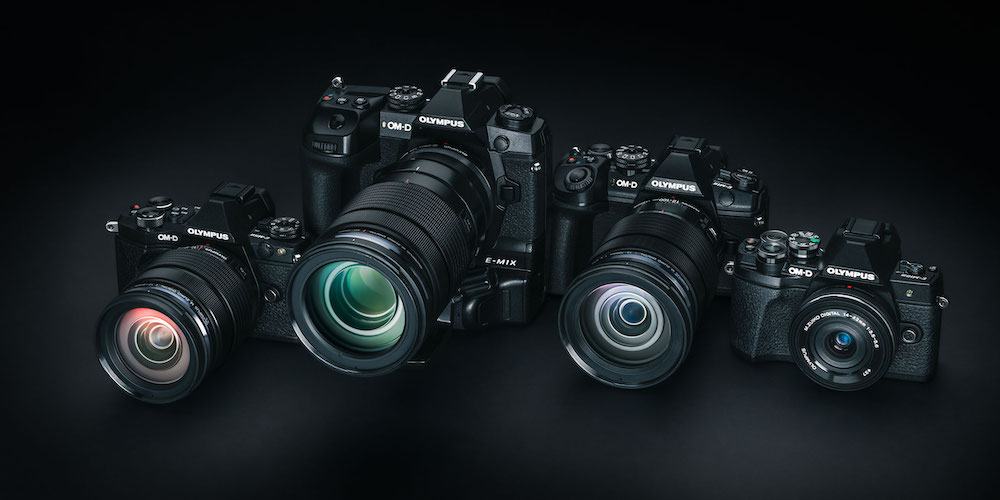
An Olympus family portrait
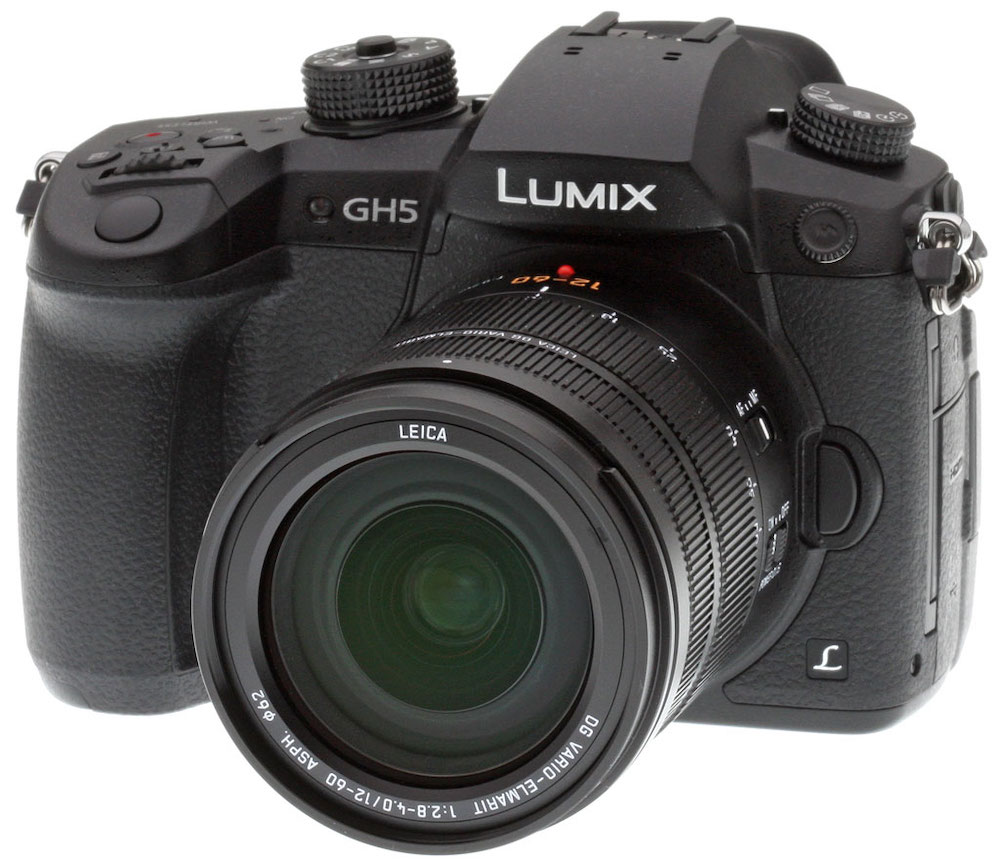
And a Panasonic GH5, equal parts camera and camcorder
Panasonic, one of the two manufacturers using the Micro 4/3 standard, released the first mirrorless interchangeable-lens camera using an electronic viewfinder the world had ever seen in September, 2008. Olympus followed with their first models the next year. The sensor is much smaller than any other current mirrorless offering (25% the size of full frame, and a little more than half the size of APS-C), which has both advantages and disadvantages. On the plus side, the smallest Micro 4/3 bodies and lenses are really tiny, and the larger bodies often pack features that are hard for larger-sensor cameras to match, including an uncanny image-stabilization system on some Olympus bodies that can produce sharp images handheld at shutter speeds as slow as ½ second with many lenses, and even longer in some circumstances. The disadvantage is that the small sensors, which are also older designs, lag almost every other interchangeable lens camera in resolution and dynamic range. Occasionally, in the wrong scene, the image quality difference will be visible even in a web image – the resolution is fine, but the compromised dynamic range may show up. There are tiny lenses, and there are excellent lenses, but the excellent lenses tend not to be tiny.

A Panasonic GX850 – at 12 ozs with the tiny 12-32 mm zoom, it’s about as small and light as it’s possible to get and still have interchangeable lenses… It’s lighter than most lenses, and it includes a camera, battery and card…
If you are looking for the smallest possible kit of a body and any given focal length range of lenses, it’s probably Micro 4/3. If you are looking for a fast, rugged camera for action photography, Olympus’ E-M1 mk II is half the size and ¼ the price of Canon’s and Nikon’s top DSLRs (and long lenses add to both the size and price differences), and the feature deficit is surprisingly small. For many years, Panasonic’s GH series offered more sophisticated video features than anything short of a full-fledged digital cinema camera several times the weight and price. While the video gap has closed, today’s GH5 is still among the most capable still/video hybrids available. Olympus’ E-M5 mkII with a weathersealed lens is a small, light rugged option for tough conditions.
B&H reports the availability of 181 lenses for Micro 4/3, which include some cosmetic variants and kits (“lens with filter” may be a separate listing from “lens alone”). More than half of those are manufactured by Panasonic and Olympus, and another 15 or so are manufactured by Sigma, Tamron and other well-known third parties. Around 30 of the hundred or so lenses made by well known manufacturers are professional-grade optics ranging from an 8mm fisheye to a 300mm telephoto.
The remaining 40% or so of the lenses are primarily manual-focus lenses from lesser-known names. Many of the manual-focus lenses are simply inexpensive – quite a few of them are under $100. The more interesting of the manual focus lenses are a menagerie of optical exotica unequalled in any other mount. There are multiple fisheye lenses (one of which is a fisheye zoom), several lenses faster than f1 (one of which is f0.85), several macro lenses that focus closer than 1:1 and a 300mm telephoto lens that looks like a 50mm lens (it’s a catadioptric lens that uses mirrors to fold the incoming light back on itself). Not all of the beasts in this optical zoo are inexpensive.
With all these lenses to choose from, is anything missing? Tilt/shift lenses are unavailable – they only come in Nikon and Canon DSLR mounts as of this writing, and the best way to access them on a mirrorless camera is with a Nikon or Canon mirrorless body and the manufacturer’s adapter to their own DSLR lenses. Third-party adapters from, say, Canon to Sony also work.
Long lenses are generally not a problem on Micro 4/3, because the small sensor means that any given lens has the same field of view as a lens twice as long on full-frame. There’s a relatively compact 100-400mm f4-6.3 zoom, which has the field of view of an 800mm lens when zoomed all the way in! The issue is that lenses have two stops of more depth of field on the small sensor than a lens twice as long would on full-frame. That 400mm f6.3 only isolates its subject like an 800mm f13. An 800mm f5.6 offers far superior subject isolation, and Canon and Nikon are both happy to sell one – but it costs well over $10,000, weighs 10 lbs and is 18” long even without its enormous lens hood. After carrying one for a while, many photographers will wish for the little Panasonic 100-400mm zoom.
Unfortunately, less exotic, but subject-isolating telephotos are often not available. The only 200mm prime currently available is f2.8, which translates to a 400mm f5.6 in full-frame terms. The 300mm is an f4 lens (600mm f8). There is no autofocus option other than zooms at 100mm or 150mm, so the shallowest depth of field in either a 200 or 300mm telephoto is only f5.6 equivalent from a 40-150mm f2.8 zoom. Lots of length, reasonable prices and weights, but much of it is slow (which may not matter, depending on the application).
Subject isolation is a recurring issue for photographers who prefer shallow depth of field – to reach the equivalent field of view and depth of field, Micro 4/3 requires a lens half as long, but two stops faster than full-frame. The best Micro 4/3 lenses tend to have similar maximum apertures to the best lenses in other formats, or sometimes they are ½ to 1 stop faster. As an example, the Olympus Pro 25mm f1.2 is a excellent “normal” lens, with superb optical quality (as it should be for $1199). Unless you are after minimum depth of field, it is one of the best normal lenses for any format. If you are trying to isolate a subject, however, it is only equivalent to a 50mm f2.4 on full-frame, or a 35mm f1.8 on APS-C. Zooms are even more of an issue – the higher-end Micro 4/3 zooms are constant-aperture f2.8 and f4 designs, which only offer similar subject isolation to f5.6 consumer zooms, or even to f8 zooms.
Micro 4/3 can take essentially any lens ever made on an adapter. Almost all of the adapters are manual, losing autofocus if the lens ever had it as well as substantial amounts of exposure automation. Not only are all western SLR lens (both film and digital) mounts covered, but older rangefinder mounts are as well – and not just Leica, but old Nikon S, Contax and others. Most medium format lenses can be adapted to Micro 4/3, although even a wide-angle on medium format will be a relatively long lens on Micro 4/3, due to the sensor size. Eastern bloc mounts like Exacta and Pentacon? No problem. Cinema, video and even security camera lenses? Sure. Enlarger lenses? Them too… There must be a way to mount a slide projector lens or a microscope objective?
Battery life varies widely among bodies – both Olympus and Panasonic use various batteries, depending on the size of the body. The longest-lived batteries are excellent, but some bodies use tiny batteries. Similarly, given the diversity of the system, cameras and lenses range from fragile to bulletproof. Image stabilization is an odd, but generally good, situation – most Olympus, and a few Panasonic, bodies are stabilized (the in-body stabilizer on some of the higher-end Olympus bodies is exceptional). Some lenses are also stabilized. The combination of certain stabilized Olympus lenses with a stabilized Olympus body is additive, producing the ”handheld at ½ second or longer” level of stabilization. It is also possible to match an unstabilized body to a unstabilized lens, producing an unstabilized combination – sometimes without realizing it. The flash situation on Micro 4/3 is similar to Fujifilm – multiple options, but not as standard as Canon, Nikon or Sony
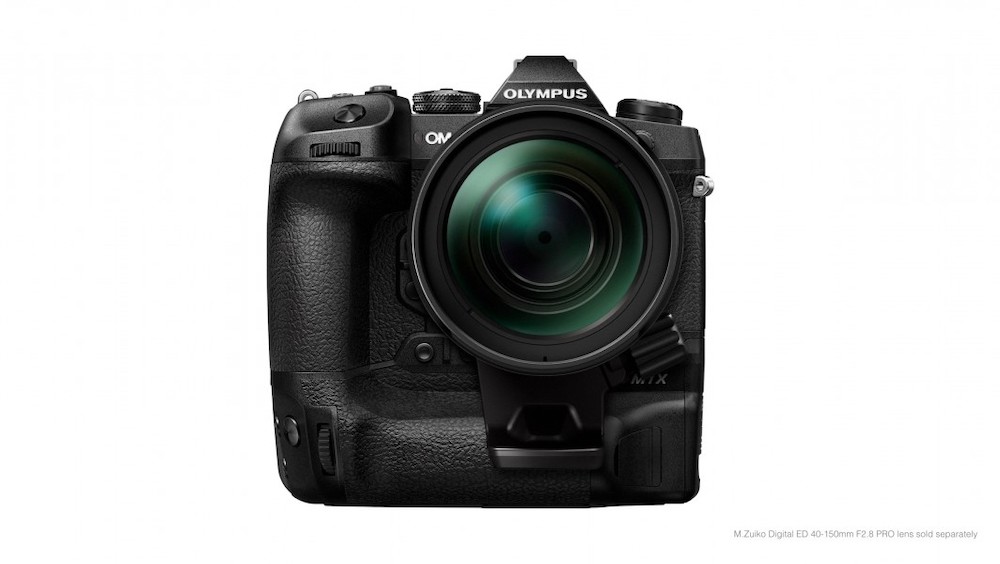
An Olympus E-M1x – it is heavier than the medium-format Fujifilm GFX50R (but, to be fair, the GFX doesn’t shoot 60 fps stills!)
Micro 4/3 is increasingly becoming a specialist format, focused on action, compactness and video. There is nothing better for, say, high school sports – bodies and lenses that give much of the feel and utility of a $15,000 Canon or Nikon setup are available for a fraction of the price. An E-M5 mk II with a compact zoom or two is a rugged backpacking companion with image quality leagues better than a phone – sure, a Fujifilm X-T3 or a Nikon Z7 would offer higher image quality, but both are also larger and heavier. A Panasonic GH5 is a budding cinematographer’s choice, and you might dip into the optical zoo for some scenes that no other format can offer. Micro 4/3 is probably not the best choice for general photography unless you know why you want it, but it offers some spectacular high points.
Nikon:
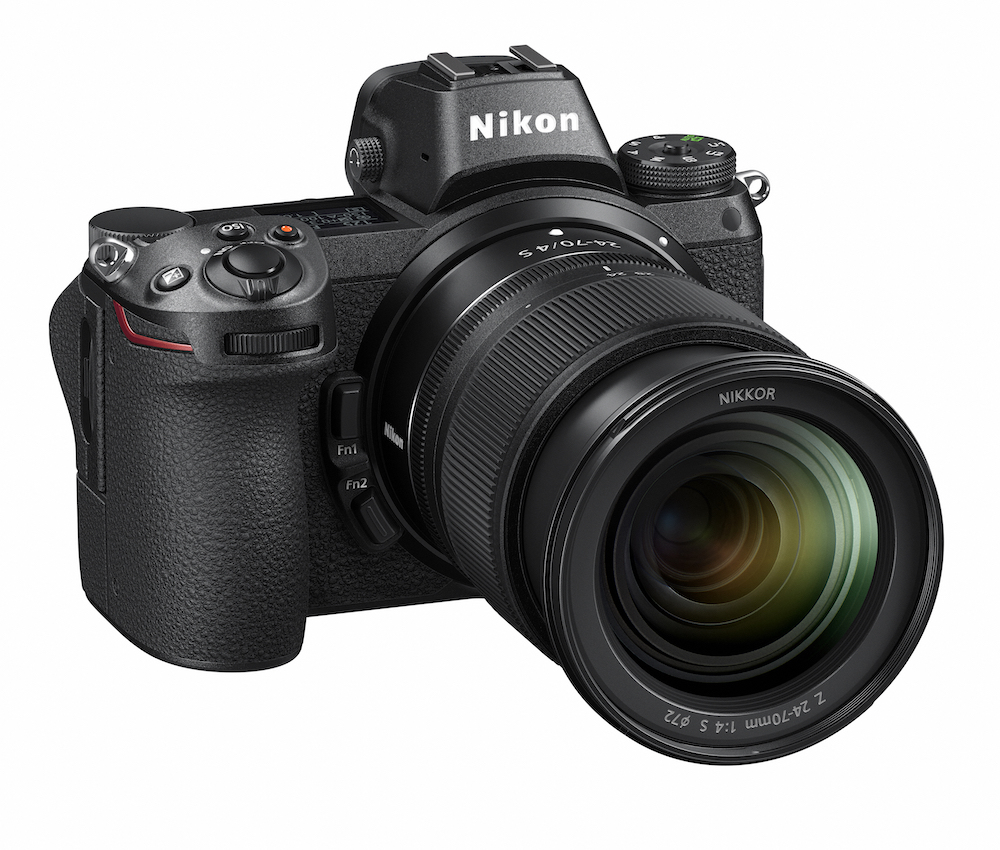
A Nikon Z7
From the release of the Fujifilm X-Pro1 and Canon EOS-M in 2012 to the summer of 2018, no significant player joined the mirrorless world. There were a few new mounts released, but they were either small-sensor curiosities (Pentax Q, Nikon 1), medium-format (Hasselblad X, Fujifilm GFX) or two variants of Leica’s L mount (it was not until late 2018 that anyone other than Leica made L mount bodies or lenses – until then, Leica pricing kept the L mount on the fringes). Within a few weeks in the late summer and early autumn of 2018, first Nikon, then Canon released full-frame mirrorless systems with significant commitments to build full systems of bodies and lenses (Canon’s earlier APS-C EOS-M line offered some nice bodies, but the few lenses available were almost exclusively inexpensive “kit” type optics).

And most of the native lenses available today
Of the two releases, Nikon’s was the better coordinated – the initial bodies made sense with the initial lenses. The first release was two bodies, including one using the ultra-high resolution image sensor from the Nikon D850 DSLR, two prime lenses (35mm and 50mm, both f1.8) and a compact 24-70mm f4 zoom. Nikon also showed a prototype of a huge, heavy expensive 58mm f0.95 . Since then, while the 58mm f0.95 has not surfaced, we’ve seen a remarkably compact 14-30mm f4, a 24-70mm f2.8, and are expecting an 85mm f1.8 portrait lens in the immediate future, along with a 70-200mm f2.8 in the next couple of months and a 24mm f1.8 by the end of the year. Image stabilization is standard in both bodies (and presumably in future bodies as well), so none of the native lenses are stabilized.

Red dirt in Arches
The theme of the Nikon Z system is quality, compactness and ruggedness. The bodies and lenses are built to the same standards as Nikon’s professional D850 DSLR according to Nikon claims, and from the 100 degree heat and dust of Arches National Park in June to a surprise rainstorm on a Northern California beach and a day of downpours while backpacking in the Adirondacks, my own Z7 has survived quite a bit. Despite the excellent image quality, I have never used Sony cameras extensively for my personal work – the two things that had kept me away were the inadequate sealing and the size and weight of some of the better lenses. Nikon addressed both of these issues in the initial release of the Z system.

And pouring rain in the Five Ponds Wilderness – neither one fazed the Z7
The Z6 and Z7 bodies look identical except for the label on the front. Both feel like a smaller version of a professional Nikon DSLR in the hand – specifically, the controls are as close to the D850 as Nikon could make them. The important internal difference between the two models is that the Z6 uses a recent version of the ubiquitous Sony 24 MP full-frame sensor, while the Z7 uses a modification of the 46 MP D850 sensor (also a Sony design, although modified to Nikon’s specifications).
The lenses are of remarkable quality for their size and weight. Apart from the announced, but not released 58mm f0.95, all of them are of modest aperture – but that allows them to be smaller and lighter. The 24-70mm f4 is one of the best standard zooms I have used, easily fitting into the same category with modern 24-70mm f2.8 lenses and the Fujifilm 16-55 f2.8. Because it is a stop slower, it is literally half the weight of its full-frame competitors (and 1/3 lighter even than the APS-C Fujifilm lens). It is only slightly heavier than the Olympus PRO 12-40mm f2.8, another excellent lens, but one that only has to cover a Micro 4/3 sensor ¼ the size of the Nikon’s. I do not own the 35mm or 50mm primes, but reviews have used names like “Sigma ART” and even “Otus” when looking for comparisons – excellent lenses multiple times heavier than the little Nikkors.
As Nikon fills out the system, larger, heavier, faster lenses of ultimate quality will probably join the collection of compact, high-quality optics. Right now, the Z lens line Is limited, although what there is is very promising. The body lineup is simple – one 24 MP body for general photography, with excellent video features as well, plus one pixel monster for printing big. There is no video body, there is no economy model, and there is no ultra high-speed body for sports and action. If either a 24 MP generalist or a 46 MP pixel monster meets your needs, the Z bodies are well-made both from an ergonomic and a durability standpoint.
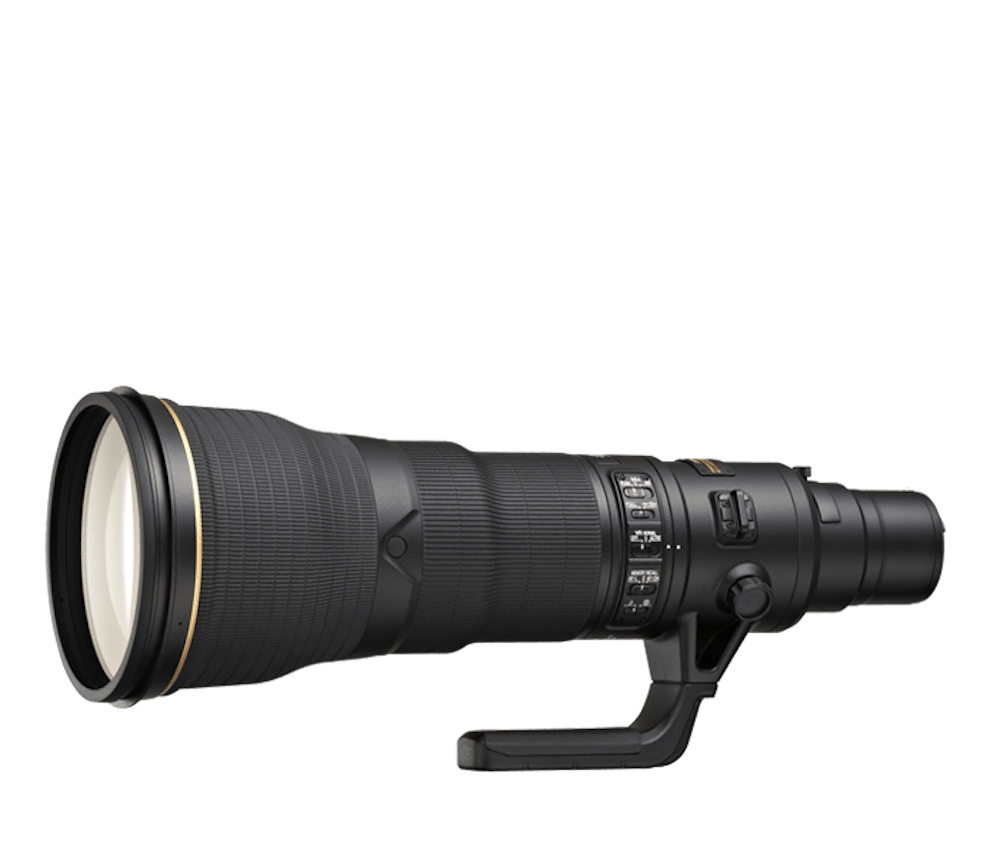
No long lenses in the Z lineup? This 800mm f5.6 will work very well on the FTZ adapter (although I’d rather carry the 500mm f5.6 PF!)
Nikon and Canon have one important advantage over other manufacturers when it comes to lens selection. Each makes an adapter that fits their extensive DSLR lens lines to their mirrorless bodies. While one way of looking at the Z lens lineup is “five nice lenses with a couple more coming soon, nothing faster than f1.8 or longer than 70mm (soon to be 200mm)”, it is equally accurate to say “compatible with 60 years of lenses ranging from a 6mm fisheye to a 1200-1700mm zoom, including multiple tilt/shift lenses and other exotics”. Unlike manual adapters that are widely available for other systems, autofocus (with most newer lenses) and autofocus are preserved, and work almost exactly as they do on a DSLR. Unlike electronic adapters made for a number of systems (notably Sony) by small companies, the official Nikon FTZ adapter will reliably transmit electronic signals every time. Nikon certainly understands both the lens and body signaling – they made both of them, and the Z mount was specifically designed to be compatible with Nikon F mount electronics, so lens adapters could be fully reliable. Weather resistance is preserved, if the lens is sealed, and image stabilization is actually added to lenses that don’t have it, because the Z bodies have very good in-body stabilizers.
Similarly, most Nikon DSLR accessories work with the Z system. The EN-EL 15B battery is shared with most mid-line and upper end Nikon DSLRs, and it provides very decent battery life, although not as good as the newer “big-battery” Sonys. Flash compatibility is modern Nikon, one of the two most common systems, available for purchase or rent anywhere. The fact that the Z system takes Nikon accessories takes all the worry out of it – Nikon gear is everywhere. Most Nikon DSLR shooters looking to add or move to mirrorless should be very happy with the Z system, unless they were waiting for an equivalent to a D5.
Canon:
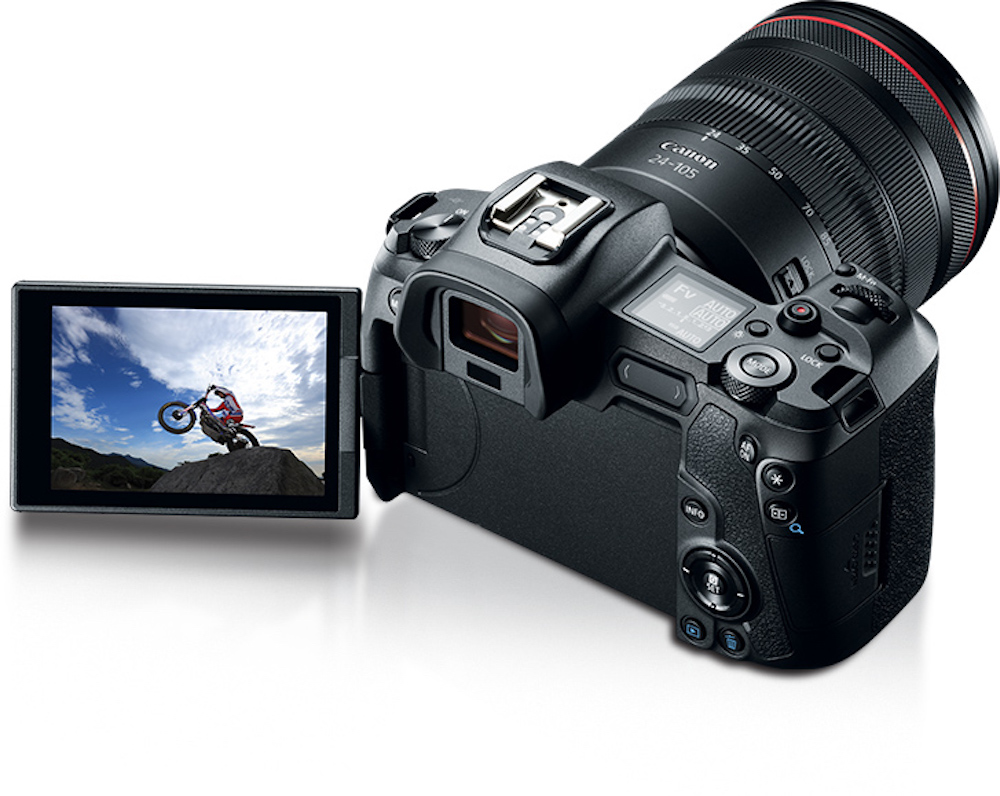
A Canon EOS-R
Like Nikon, Canon was a late entrant to the full-frame mirrorless game. They have actually been selling an APS-C mirrorless system (EOS-M) since 2012, but they have never supported it with lenses of interest to serious photographers. Most EF-M lenses are very slow (f6.3 on the long end is standard), inexpensive kit or travel zooms. There is one macro lens, but its very short 28mm focal length is a challenge. There is one fast (f1.4) lens, but there’s only a 32.5mm (50mm equivalent). The only decent lenses are adapted EF DSLR lenses, and many photographers have questioned whether there’s any advantage to a mirrorless system that always uses a lens adapter.
When they released their full-frame EOS-R system, Canon was determined to show from the very beginning that they were serious about lenses. Two of their initial four lenses retail for over $2000 each, and are high-end, bordering on exotic, designs (a 50mm f1.2 and a 28-70mm f2.0). The remaining two lenses are a 35mm macro lens (what is it with Canon and very short macro lenses) and a 24-105mm f4 zoom. Other than the little macro lens, all are much bigger and heavier than Nikon’s initial lenses, with the two high-end lenses being especially heavy. Two lenses have reached the market since the initial group – one is a 24-240mm travel zoom and the other is another big, heavy exotic – an 85mm f1.2. The next scheduled lenses include 15-35, 24-70 and 70-200 f2.8 zooms.

And a Canon 28-70mm f2.0 (the aperture’s not a typo, but this doesn’t show how big and heavy it is – it’s about the size and weight of a typical 70-200mm f2.8, although a different shape )
The fundamental disconnect in the Canon EOS-R system is that the two initial bodies do not match the high-end lenses well. The first body released was the midrange EOS-R, a direct competitor to the 24 MP Sony A7 III and Nikon Z6. Its resolution is slightly higher, at 30 MP, but the older, Canon-manufactured sensor lags behind the latest Sony-made sensors. Looking at the initial lenses, the second logical body would have been a high-resolution model (or perhaps a high-speed body). Instead, Canon released the inexpensive EOS-RP, positioned below the EOS-R. It would be the least expensive full-frame mirrorless camera in existence, except for Sony’s habit of leaving older models on the market at steep discounts.
The 50mm f1.2, 85 mm f1.2 and 28-70mm f2.0 are all enigmas – all are very high-end lenses that are extremely well-reviewed – and there is no camera to match their potential. Even the 24-105 may be more lens than the EOS-R needs, and it is out of place on the EOS-RP. The 24-240 travel lens makes sense on either body, for photographers who like that sort of lens. The little 35mm macro lens also makes sense on both bodies, as much as a 35mm macro lens makes sense.
Canon has a high-end mirrorless lens system, just waiting for cameras – and they have a midrange mirrorless camera system, just waiting for lenses. The situation is absurd enough that the standard kit lens for the EOS-RP is a Canon DSLR lens on an adapter (none of the EF-R lenses are inexpensive enough). Neither body is image stabilized – and neither are the high-end lenses (the 24-105mm, 24-240mm and 35mm macro lenses are stabilized). A high-resolution, stabilized body would go a long way towards explaining the lenses, and some affordable, stabilized lenses would help explain the bodies.

The initial RF lenses are relatively standard (if fast) – but Canon makes very reliable adapters to use any Canon DSLR lens – including this 17mm f4 tilt-shift lens – no other system features one…
Other than the puzzling mismatch between bodies and lenses, Canon got quite a bit right. The bodies share accessories, including batteries, with Canon DSLRs. Not only does Canon make a reliable adapter to use EF DSLR lenses, they actually make three (one has an additional control ring, and another allows filters between body and lens). The weather sealing, while not up to Nikon, Olympus or Fujifilm standards, is what one might expect on midrange and economy full-frame bodies (the Nikon Z6 is unusually good in this regard because it inherits the weather sealing from the higher-end Z7).
This collection of mismatched parts will not entice anyone already shooting Sony to switch to Canon, nor should it encourage people coming from Nikon or smaller-format systems (although people contemplating a system switch may want to wait to see how it sorts out). The real question is for people who have been waiting for Canon, because they want to add or move to mirrorless from a Canon DSLR system. At the high end, the question will be the performance of whatever sensor Canon chooses to use in the next body they release. If it has the weaknesses of the 5Ds and 5DsR sensor (low dynamic range and higher high ISO noise), it may not cause people to stay with Canon – but, if it performs on a level with modern Sony sensors, the EF-R lenses look really promising.
L mount:
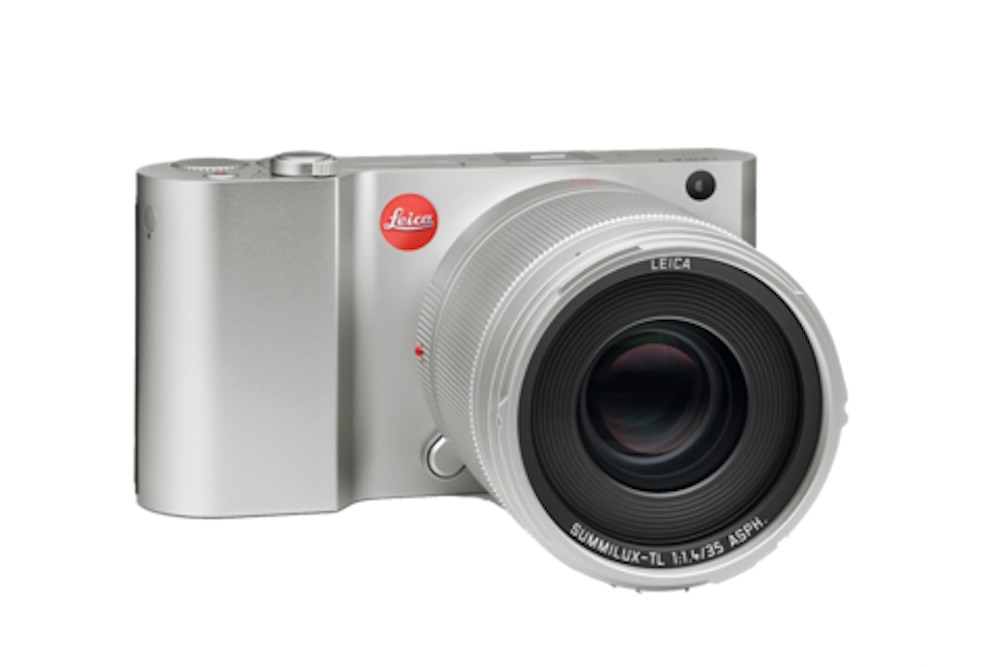
Brand new L mount? Here’s a 2014 Leica T
While it was perhaps obscure until Panasonic and Sigma joined the L-Mount Alliance in late 2018, the Leica Lmount actually dates to April of 2014. Leica introduced it on the Leica T, a 16 MP APS-C camera. It was originally called the T mount, and was renamed L mount somewhere along the line – perhaps due to confusion with the T mount standard for attaching cameras to telescopes, microscopes and other optics? The full-frame Leica SL adopted the mount in 2015, but it was large, heavy, massively overpriced (3x the price of a comparable Sony) and lingered on the market without updates.
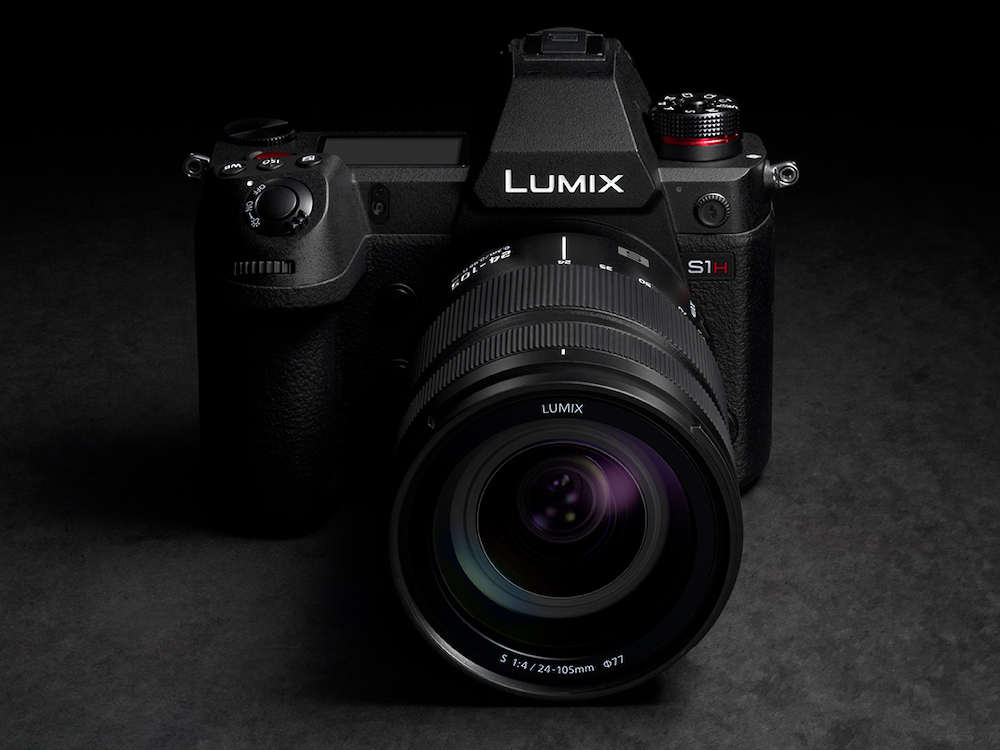
But this video-focused Panasonic S1h will probably sell many more copies than the Leicas
The L system was never unique in the manner of the M or many other Leica products – rather than an expensive camera that offered some (extremely) unusual pluses and minuses, it was a relatively conventional camera at a very high price. The lenses were, of course, excellent, but were they any better than the best Sony G-Masters, Nikon ED lenses, Canon L glass or red badge Fujinons? Leica was trying to sell a 24 MP full-frame camera for a price that would easily buy 50 MP medium format (and the SL isn’t really smaller or lighter than a GFX 50S), and it wasn’t iconoclastic like so many other Leica products.
The L mount was essentially forgotten until Panasonic decided to release two new L mount bodies in late 2018 – at prices that reflected the rest of the market. At the same time, the L mount became a relatively open standard (manufacturers have to join the L Mount Alliance, but they are not averse to additional members), and Sigma committed to building lenses and even bodies to the L mount standard as well.
The Panasonic S1 and S1r appear to use variants on Sony sensors we have seen before (24 MP in the S1, 47 MP in the S1r). Noise and dynamic range charts look uncannily like the Nikon Z6 and Z7, respectively – enough that, if the sensor heritage is not common with the Nikons and related Sonys, it’s something that performs very similarly. The bodies are notably larger and heavier than most other mirrorless options, although they are comparable to good-sized DSLRs and comfortable in the hand.
Like the bodies, the initial crop of Panasonic lenses are all larger and heavier than many of their direct competitors. Three lenses (50mm f1.4, 24-105mm f4, 70-200mm f4) were released with the bodies, adding to seven Leica lenses, three of which have very similar specifications to Panasonic’s lenses.
Sigma has released quite a few of their ART lenses in L mount, but most of these are not actually mirrorless lenses – they are existing DSLR lenses stretched at the back end, effectively incorporating a permanent mount adapter. Stretched DSLR lenses cannot take advantage of the size, weight or performance advantages of dedicated mirrorless designs. The ART lenses are excellent performers, but they are notably large and heavy. Sigma has just released a few dedicated mirrorless designs in L mount, including a very compact 45mm f2.8. They are promising more dedicated mirrorless designs in the near future, and Sigma is one of the best lensmakers out there, as well as a company willing to take risks, so it will be interesting to see what they come up with.
What are the advantages of large and heavy bodies that don’t push the envelope in any way, and that use a lens mount that is incompatible with the lenses most people have? Panasonic is noted for their video expertise, both in their Micro 4/3 bodies and in a very well-respected line of professional video cameras. The video specifications of the 24 MP S1 in particular are excellent, and there is a paid firmware upgrade coming that pushes them beyond other full-frame mirrorless cameras, including 10-bit LOG recording. A dedicated video body, the S1h, announced but not released, promises to push the video capabilities further.
The other notable feature in the Panasonic bodies is a high-resolution multishot mode. The S1 can capture 100 MP files from multiple exposures, while the S1r will go as high as 187 MP. It requires a sturdy tripod, and there are few published results about how well it handles motion (Panasonic claims some motion handling). Even if its motion handling is very limited, it allows for extremely high resolution capture in still life, art reproduction and similar applications. If it handles motion reasonably well, which there are hints that it might, it could be useful for landscapes as well.
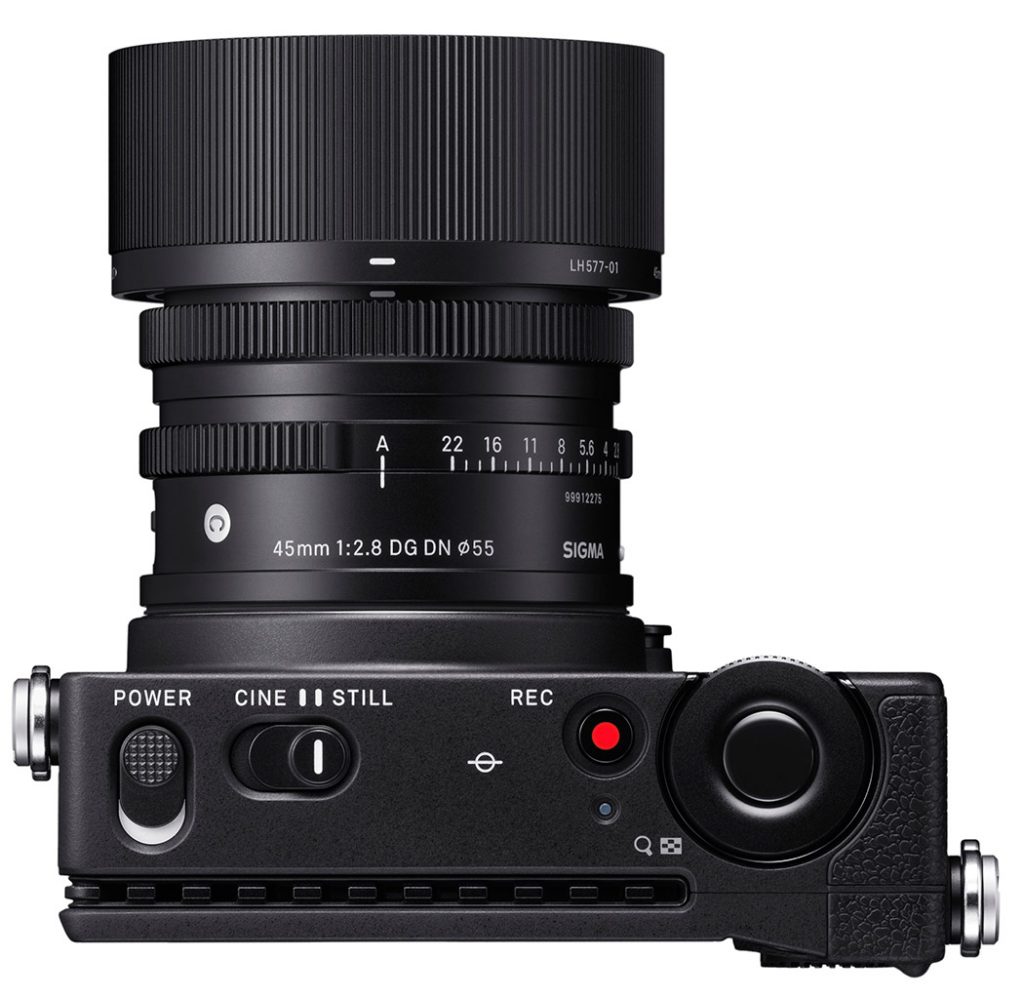
Does it look comfortable to use? No viewfinder or grip but making those optional also allows for creative placement for different applications – a Sigma fp
The wild card in the L mount alliance is Sigma. Sigma has always made creative, iconoclastic (if not always practical) camera bodies in addition to their excellent lenses. Sigma recently announced the fp, a tiny body that more or less reimagines what parts need to be in a camera. It is missing a grip, a viewfinder, an image stabilizer, and even a shutter in the interests of compactness. It uses a standard 24 MP full-frame sensor, probably the ubiquitous Sony that is in so many other cameras – but it packages it completely differently. As it stands, it looks like it will probably be very uncomfortable to use – but it also looks like it is a blank slate to add whatever parts an individual photographer wants. It’s probably not ready now, but give that type of camera a much faster electronic shutter and enough pixels to handle image stabilization in software and it’s a viable way to create a fully custom camera. Give Sigma enormous credit for innovation – their Foveon sensors (forthcoming in an L mount body, probably next year) have never been “quite there” for most purposes, but they have some very interesting aspects to their image quality, and one day, they’ll work out the drawbacks.
Hasselblad X:
One body and nine very expensive lenses doesn’t count as a system in the same way that many of the systems profiled here do – but a medium format camera as small and light as this one from a legendary name in photography deserves a mention. All but two of the lenses are modest-speed primes (but that’s always been true of medium format). Battery life is terrible, and there’s no image stabilization in body or lenses – but it’s a beautifully built medium format camera (and a Hasselblad) that could be mistaken for a big APS-C camera or an average-sized full-frame camera. It could also be mistaken for an Apple product, with its minimalist user interface based largely on a touch screen.
Fujifilm’s GFX 50R uses the same sensor, is only 15 grams heavier, gets much better battery life, and has a somewhat broader system of much more reasonably priced lenses. It’s also part of a system with other bodies, including the GFX 100, and backed by a much larger company that has a less troubled recent history. Nikon’s Z7, Sony’s A7r mk II, III and IV and Panasonic’s S1r all offer very comparable image quality from high-resolution full-frame sensors, in-body image stabilization and massively broader lens lines.
If you’re the right customer for the Hasselblad X1D II, all of that is missing the point – none of the above is as beautiful an object as the Hasselblad. Most people will choose a more utilitarian camera for half the price or less, and will get the same image quality in a broader range of situations – but if the feel of the tool in your hand is as important as the work it produces, the X1D is worth a look.
Hasselblad has also produced a number of prototype cameras that reimagine modern camera design in different ways over the past few years. One very interesting model appears to be very close to production – the 907x, a tiny “sliver” camera that connects the CFV II back for the iconic V series Hasselblads to the lenses for the X1D and X1D II. Attached to the back, it is only marginally heavier than the X1D II, and the back can also fit a classic V series body or even a view camera, allowing lenses and styles of photography from an earlier era to have a new life in the digital age – at a very high quality level.
Dan Wells
September 2019

Lorem ipsum dolor sit amet, consectetur adipiscing elit, sed do eiusmod tempor incididunt ut labore et dolore magna aliqua. Ut enim ad minim veniam, quis nostrud exercitation ullamco laboris nisi ut aliquip ex ea commodo consequat. Duis aute irure dolor in reprehenderit in voluptate velit esse cillum dolore eu fugiat nulla pariatur. Excepteur sint occaecat cupidatat non proident, sunt in culpa qui officia deserunt mollit anim id est laborum.
Lorem ipsum dolor sit amet, consectetur adipiscing elit, sed do eiusmod tempor incididunt ut labore et dolore magna aliqua. Ut enim ad minim veniam, quis nostrud exercitation ullamco laboris nisi ut aliquip ex ea commodo consequat. Duis aute irure dolor in reprehenderit in voluptate velit esse cillum dolore eu fugiat nulla pariatur. Excepteur sint occaecat cupidatat non proident, sunt in culpa qui officia deserunt mollit anim id est laborum.

Lorem ipsum dolor sit amet, consectetur adipiscing elit, sed do eiusmod tempor incididunt ut labore et dolore magna aliqua. Ut enim ad minim veniam, quis nostrud exercitation ullamco laboris nisi ut aliquip ex ea commodo consequat. Duis aute irure dolor in reprehenderit in voluptate velit esse cillum dolore eu fugiat nulla pariatur. Excepteur sint occaecat cupidatat non proident, sunt in culpa qui officia deserunt mollit anim id est laborum.

Lorem ipsum dolor sit amet, consectetur adipiscing elit, sed do eiusmod tempor incididunt ut labore et dolore magna aliqua. Ut enim ad minim veniam, quis nostrud exercitation ullamco laboris nisi ut aliquip ex ea commodo consequat. Duis aute irure dolor in reprehenderit in voluptate velit esse cillum dolore eu fugiat nulla pariatur. Excepteur sint occaecat cupidatat non proident, sunt in culpa qui officia deserunt mollit anim id est laborum.

Lorem ipsum dolor sit amet, consectetur adipiscing elit, sed do eiusmod tempor incididunt ut labore et dolore magna aliqua. Ut enim ad minim veniam, quis nostrud exercitation ullamco laboris nisi ut aliquip ex ea commodo consequat. Duis aute irure dolor in reprehenderit in voluptate velit esse cillum dolore eu fugiat nulla pariatur. Excepteur sint occaecat cupidatat non proident, sunt in culpa qui officia deserunt mollit anim id est laborum.
Lorem ipsum dolor sit amet, consectetur adipiscing elit, sed do eiusmod tempor incididunt ut labore et dolore magna aliqua. Ut enim ad minim veniam, quis nostrud exercitation ullamco laboris nisi ut aliquip ex ea commodo consequat. Duis aute irure dolor in reprehenderit in voluptate velit esse cillum dolore eu fugiat nulla pariatur. Excepteur sint occaecat cupidatat non proident, sunt in culpa qui officia deserunt mollit anim id est laborum.
Lorem ipsum dolor sit amet, consectetur adipiscing elit, sed do eiusmod tempor incididunt ut labore et dolore magna aliqua. Ut enim ad minim veniam, quis nostrud exercitation ullamco laboris nisi ut aliquip ex ea commodo consequat. Duis aute irure dolor in reprehenderit in voluptate velit esse cillum dolore eu fugiat nulla pariatur. Excepteur sint occaecat cupidatat non proident, sunt in culpa qui officia deserunt mollit anim id est laborum.
Lorem ipsum dolor sit amet, consectetur adipiscing elit, sed do eiusmod tempor incididunt ut labore et dolore magna aliqua. Ut enim ad minim veniam, quis nostrud exercitation ullamco laboris nisi ut aliquip ex ea commodo consequat. Duis aute irure dolor in reprehenderit in voluptate velit esse cillum dolore eu fugiat nulla pariatur. Excepteur sint occaecat cupidatat non proident, sunt in culpa qui officia deserunt mollit anim id est laborum.

Lorem ipsum dolor sit amet, consectetur adipiscing elit, sed do eiusmod tempor incididunt ut labore et dolore magna aliqua. Ut enim ad minim veniam, quis nostrud exercitation ullamco laboris nisi ut aliquip ex ea commodo consequat. Duis aute irure dolor in reprehenderit in voluptate velit esse cillum dolore eu fugiat nulla pariatur. Excepteur sint occaecat cupidatat non proident, sunt in culpa qui officia deserunt mollit anim id est laborum.
Lorem ipsum dolor sit amet, consectetur adipiscing elit, sed do eiusmod tempor incididunt ut labore et dolore magna aliqua. Ut enim ad minim veniam, quis nostrud exercitation ullamco laboris nisi ut aliquip ex ea commodo consequat. Duis aute irure dolor in reprehenderit in voluptate velit esse cillum dolore eu fugiat nulla pariatur. Excepteur sint occaecat cupidatat non proident, sunt in culpa qui officia deserunt mollit anim id est laborum.
Lorem ipsum dolor sit amet, consectetur adipiscing elit, sed do eiusmod tempor incididunt ut labore et dolore magna aliqua. Ut enim ad minim veniam, quis nostrud exercitation ullamco laboris nisi ut aliquip ex ea commodo consequat. Duis aute irure dolor in reprehenderit in voluptate velit esse cillum dolore eu fugiat nulla pariatur. Excepteur sint occaecat cupidatat non proident, sunt in culpa qui officia deserunt mollit anim id est laborum.

Lorem ipsum dolor sit amet, consectetur adipiscing elit, sed do eiusmod tempor incididunt ut labore et dolore magna aliqua. Ut enim ad minim veniam, quis nostrud exercitation ullamco laboris nisi ut aliquip ex ea commodo consequat. Duis aute irure dolor in reprehenderit in voluptate velit esse cillum dolore eu fugiat nulla pariatur. Excepteur sint occaecat cupidatat non proident, sunt in culpa qui officia deserunt mollit anim id est laborum.

Lorem ipsum dolor sit amet, consectetur adipiscing elit, sed do eiusmod tempor incididunt ut labore et dolore magna aliqua. Ut enim ad minim veniam, quis nostrud exercitation ullamco laboris nisi ut aliquip ex ea commodo consequat. Duis aute irure dolor in reprehenderit in voluptate velit esse cillum dolore eu fugiat nulla pariatur. Excepteur sint occaecat cupidatat non proident, sunt in culpa qui officia deserunt mollit anim id est laborum.

Lorem ipsum dolor sit amet, consectetur adipiscing elit, sed do eiusmod tempor incididunt ut labore et dolore magna aliqua. Ut enim ad minim veniam, quis nostrud exercitation ullamco laboris nisi ut aliquip ex ea commodo consequat. Duis aute irure dolor in reprehenderit in voluptate velit esse cillum dolore eu fugiat nulla pariatur. Excepteur sint occaecat cupidatat non proident, sunt in culpa qui officia deserunt mollit anim id est laborum.
Lorem ipsum dolor sit amet, consectetur adipiscing elit, sed do eiusmod tempor incididunt ut labore et dolore magna aliqua. Ut enim ad minim veniam, quis nostrud exercitation ullamco laboris nisi ut aliquip ex ea commodo consequat. Duis aute irure dolor in reprehenderit in voluptate velit esse cillum dolore eu fugiat nulla pariatur. Excepteur sint occaecat cupidatat non proident, sunt in culpa qui officia deserunt mollit anim id est laborum.

Lorem ipsum dolor sit amet, consectetur adipiscing elit, sed do eiusmod tempor incididunt ut labore et dolore magna aliqua. Ut enim ad minim veniam, quis nostrud exercitation ullamco laboris nisi ut aliquip ex ea commodo consequat. Duis aute irure dolor in reprehenderit in voluptate velit esse cillum dolore eu fugiat nulla pariatur. Excepteur sint occaecat cupidatat non proident, sunt in culpa qui officia deserunt mollit anim id est laborum.
Lorem ipsum dolor sit amet, consectetur adipiscing elit, sed do eiusmod tempor incididunt ut labore et dolore magna aliqua. Ut enim ad minim veniam, quis nostrud exercitation ullamco laboris nisi ut aliquip ex ea commodo consequat. Duis aute irure dolor in reprehenderit in voluptate velit esse cillum dolore eu fugiat nulla pariatur. Excepteur sint occaecat cupidatat non proident, sunt in culpa qui officia deserunt mollit anim id est laborum.
Lorem ipsum dolor sit amet, consectetur adipiscing elit, sed do eiusmod tempor incididunt ut labore et dolore magna aliqua. Ut enim ad minim veniam, quis nostrud exercitation ullamco laboris nisi ut aliquip ex ea commodo consequat. Duis aute irure dolor in reprehenderit in voluptate velit esse cillum dolore eu fugiat nulla pariatur. Excepteur sint occaecat cupidatat non proident, sunt in culpa qui officia deserunt mollit anim id est laborum.
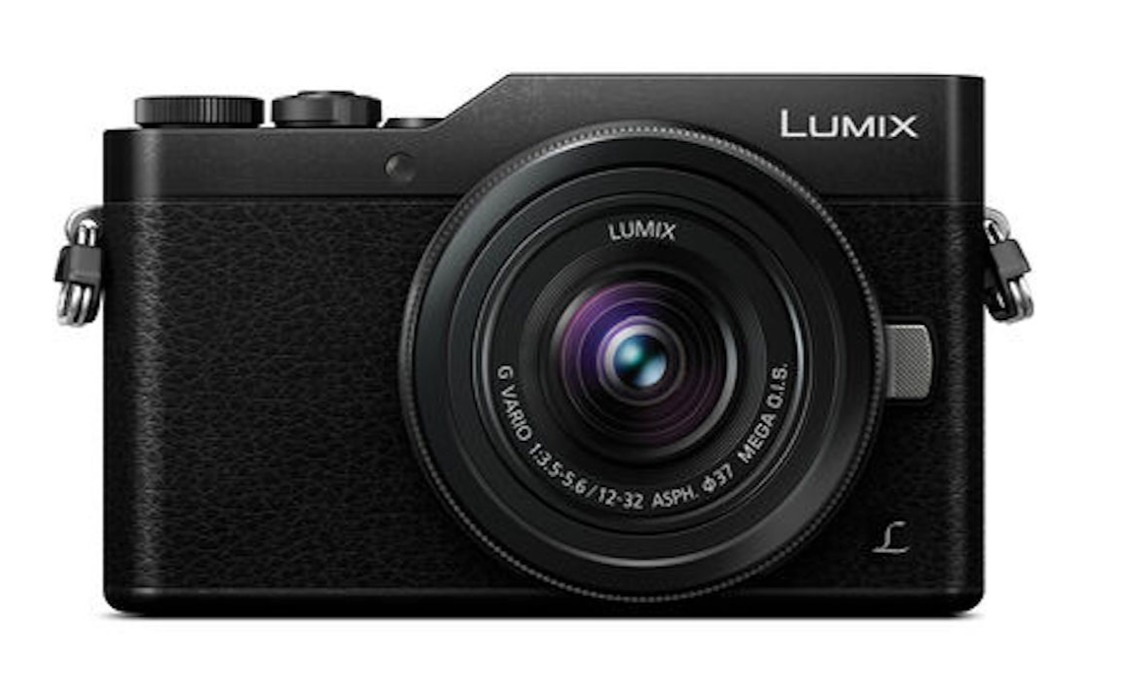
Lorem ipsum dolor sit amet, consectetur adipiscing elit, sed do eiusmod tempor incididunt ut labore et dolore magna aliqua. Ut enim ad minim veniam, quis nostrud exercitation ullamco laboris nisi ut aliquip ex ea commodo consequat. Duis aute irure dolor in reprehenderit in voluptate velit esse cillum dolore eu fugiat nulla pariatur. Excepteur sint occaecat cupidatat non proident, sunt in culpa qui officia deserunt mollit anim id est laborum.

Lorem ipsum dolor sit amet, consectetur adipiscing elit, sed do eiusmod tempor incididunt ut labore et dolore magna aliqua. Ut enim ad minim veniam, quis nostrud exercitation ullamco laboris nisi ut aliquip ex ea commodo consequat. Duis aute irure dolor in reprehenderit in voluptate velit esse cillum dolore eu fugiat nulla pariatur. Excepteur sint occaecat cupidatat non proident, sunt in culpa qui officia deserunt mollit anim id est laborum.
Lorem ipsum dolor sit amet, consectetur adipiscing elit, sed do eiusmod tempor incididunt ut labore et dolore magna aliqua. Ut enim ad minim veniam, quis nostrud exercitation ullamco laboris nisi ut aliquip ex ea commodo consequat. Duis aute irure dolor in reprehenderit in voluptate velit esse cillum dolore eu fugiat nulla pariatur. Excepteur sint occaecat cupidatat non proident, sunt in culpa qui officia deserunt mollit anim id est laborum.
Lorem ipsum dolor sit amet, consectetur adipiscing elit, sed do eiusmod tempor incididunt ut labore et dolore magna aliqua. Ut enim ad minim veniam, quis nostrud exercitation ullamco laboris nisi ut aliquip ex ea commodo consequat. Duis aute irure dolor in reprehenderit in voluptate velit esse cillum dolore eu fugiat nulla pariatur. Excepteur sint occaecat cupidatat non proident, sunt in culpa qui officia deserunt mollit anim id est laborum.

Lorem ipsum dolor sit amet, consectetur adipiscing elit, sed do eiusmod tempor incididunt ut labore et dolore magna aliqua. Ut enim ad minim veniam, quis nostrud exercitation ullamco laboris nisi ut aliquip ex ea commodo consequat. Duis aute irure dolor in reprehenderit in voluptate velit esse cillum dolore eu fugiat nulla pariatur. Excepteur sint occaecat cupidatat non proident, sunt in culpa qui officia deserunt mollit anim id est laborum.
Lorem ipsum dolor sit amet, consectetur adipiscing elit, sed do eiusmod tempor incididunt ut labore et dolore magna aliqua. Ut enim ad minim veniam, quis nostrud exercitation ullamco laboris nisi ut aliquip ex ea commodo consequat. Duis aute irure dolor in reprehenderit in voluptate velit esse cillum dolore eu fugiat nulla pariatur. Excepteur sint occaecat cupidatat non proident, sunt in culpa qui officia deserunt mollit anim id est laborum.
Lorem ipsum dolor sit amet, consectetur adipiscing elit, sed do eiusmod tempor incididunt ut labore et dolore magna aliqua. Ut enim ad minim veniam, quis nostrud exercitation ullamco laboris nisi ut aliquip ex ea commodo consequat. Duis aute irure dolor in reprehenderit in voluptate velit esse cillum dolore eu fugiat nulla pariatur. Excepteur sint occaecat cupidatat non proident, sunt in culpa qui officia deserunt mollit anim id est laborum.

Lorem ipsum dolor sit amet, consectetur adipiscing elit, sed do eiusmod tempor incididunt ut labore et dolore magna aliqua. Ut enim ad minim veniam, quis nostrud exercitation ullamco laboris nisi ut aliquip ex ea commodo consequat. Duis aute irure dolor in reprehenderit in voluptate velit esse cillum dolore eu fugiat nulla pariatur. Excepteur sint occaecat cupidatat non proident, sunt in culpa qui officia deserunt mollit anim id est laborum.
Lorem ipsum dolor sit amet, consectetur adipiscing elit, sed do eiusmod tempor incididunt ut labore et dolore magna aliqua. Ut enim ad minim veniam, quis nostrud exercitation ullamco laboris nisi ut aliquip ex ea commodo consequat. Duis aute irure dolor in reprehenderit in voluptate velit esse cillum dolore eu fugiat nulla pariatur. Excepteur sint occaecat cupidatat non proident, sunt in culpa qui officia deserunt mollit anim id est laborum.

Lorem ipsum dolor sit amet, consectetur adipiscing elit, sed do eiusmod tempor incididunt ut labore et dolore magna aliqua. Ut enim ad minim veniam, quis nostrud exercitation ullamco laboris nisi ut aliquip ex ea commodo consequat. Duis aute irure dolor in reprehenderit in voluptate velit esse cillum dolore eu fugiat nulla pariatur. Excepteur sint occaecat cupidatat non proident, sunt in culpa qui officia deserunt mollit anim id est laborum.

Lorem ipsum dolor sit amet, consectetur adipiscing elit, sed do eiusmod tempor incididunt ut labore et dolore magna aliqua. Ut enim ad minim veniam, quis nostrud exercitation ullamco laboris nisi ut aliquip ex ea commodo consequat. Duis aute irure dolor in reprehenderit in voluptate velit esse cillum dolore eu fugiat nulla pariatur. Excepteur sint occaecat cupidatat non proident, sunt in culpa qui officia deserunt mollit anim id est laborum.
Lorem ipsum dolor sit amet, consectetur adipiscing elit, sed do eiusmod tempor incididunt ut labore et dolore magna aliqua. Ut enim ad minim veniam, quis nostrud exercitation ullamco laboris nisi ut aliquip ex ea commodo consequat. Duis aute irure dolor in reprehenderit in voluptate velit esse cillum dolore eu fugiat nulla pariatur. Excepteur sint occaecat cupidatat non proident, sunt in culpa qui officia deserunt mollit anim id est laborum.
Lorem ipsum dolor sit amet, consectetur adipiscing elit, sed do eiusmod tempor incididunt ut labore et dolore magna aliqua. Ut enim ad minim veniam, quis nostrud exercitation ullamco laboris nisi ut aliquip ex ea commodo consequat. Duis aute irure dolor in reprehenderit in voluptate velit esse cillum dolore eu fugiat nulla pariatur. Excepteur sint occaecat cupidatat non proident, sunt in culpa qui officia deserunt mollit anim id est laborum.
Lorem ipsum dolor sit amet, consectetur adipiscing elit, sed do eiusmod tempor incididunt ut labore et dolore magna aliqua. Ut enim ad minim veniam, quis nostrud exercitation ullamco laboris nisi ut aliquip ex ea commodo consequat. Duis aute irure dolor in reprehenderit in voluptate velit esse cillum dolore eu fugiat nulla pariatur. Excepteur sint occaecat cupidatat non proident, sunt in culpa qui officia deserunt mollit anim id est laborum.

Lorem ipsum dolor sit amet, consectetur adipiscing elit, sed do eiusmod tempor incididunt ut labore et dolore magna aliqua. Ut enim ad minim veniam, quis nostrud exercitation ullamco laboris nisi ut aliquip ex ea commodo consequat. Duis aute irure dolor in reprehenderit in voluptate velit esse cillum dolore eu fugiat nulla pariatur. Excepteur sint occaecat cupidatat non proident, sunt in culpa qui officia deserunt mollit anim id est laborum.
Lorem ipsum dolor sit amet, consectetur adipiscing elit, sed do eiusmod tempor incididunt ut labore et dolore magna aliqua. Ut enim ad minim veniam, quis nostrud exercitation ullamco laboris nisi ut aliquip ex ea commodo consequat. Duis aute irure dolor in reprehenderit in voluptate velit esse cillum dolore eu fugiat nulla pariatur. Excepteur sint occaecat cupidatat non proident, sunt in culpa qui officia deserunt mollit anim id est laborum.
Lorem ipsum dolor sit amet, consectetur adipiscing elit, sed do eiusmod tempor incididunt ut labore et dolore magna aliqua. Ut enim ad minim veniam, quis nostrud exercitation ullamco laboris nisi ut aliquip ex ea commodo consequat. Duis aute irure dolor in reprehenderit in voluptate velit esse cillum dolore eu fugiat nulla pariatur. Excepteur sint occaecat cupidatat non proident, sunt in culpa qui officia deserunt mollit anim id est laborum.
Lorem ipsum dolor sit amet, consectetur adipiscing elit, sed do eiusmod tempor incididunt ut labore et dolore magna aliqua. Ut enim ad minim veniam, quis nostrud exercitation ullamco laboris nisi ut aliquip ex ea commodo consequat. Duis aute irure dolor in reprehenderit in voluptate velit esse cillum dolore eu fugiat nulla pariatur. Excepteur sint occaecat cupidatat non proident, sunt in culpa qui officia deserunt mollit anim id est laborum.

Lorem ipsum dolor sit amet, consectetur adipiscing elit, sed do eiusmod tempor incididunt ut labore et dolore magna aliqua. Ut enim ad minim veniam, quis nostrud exercitation ullamco laboris nisi ut aliquip ex ea commodo consequat. Duis aute irure dolor in reprehenderit in voluptate velit esse cillum dolore eu fugiat nulla pariatur. Excepteur sint occaecat cupidatat non proident, sunt in culpa qui officia deserunt mollit anim id est laborum.
Lorem ipsum dolor sit amet, consectetur adipiscing elit, sed do eiusmod tempor incididunt ut labore et dolore magna aliqua. Ut enim ad minim veniam, quis nostrud exercitation ullamco laboris nisi ut aliquip ex ea commodo consequat. Duis aute irure dolor in reprehenderit in voluptate velit esse cillum dolore eu fugiat nulla pariatur. Excepteur sint occaecat cupidatat non proident, sunt in culpa qui officia deserunt mollit anim id est laborum.
Lorem ipsum dolor sit amet, consectetur adipiscing elit, sed do eiusmod tempor incididunt ut labore et dolore magna aliqua. Ut enim ad minim veniam, quis nostrud exercitation ullamco laboris nisi ut aliquip ex ea commodo consequat. Duis aute irure dolor in reprehenderit in voluptate velit esse cillum dolore eu fugiat nulla pariatur. Excepteur sint occaecat cupidatat non proident, sunt in culpa qui officia deserunt mollit anim id est laborum.
Lorem ipsum dolor sit amet, consectetur adipiscing elit, sed do eiusmod tempor incididunt ut labore et dolore magna aliqua. Ut enim ad minim veniam, quis nostrud exercitation ullamco laboris nisi ut aliquip ex ea commodo consequat. Duis aute irure dolor in reprehenderit in voluptate velit esse cillum dolore eu fugiat nulla pariatur. Excepteur sint occaecat cupidatat non proident, sunt in culpa qui officia deserunt mollit anim id est laborum.

Lorem ipsum dolor sit amet, consectetur adipiscing elit, sed do eiusmod tempor incididunt ut labore et dolore magna aliqua. Ut enim ad minim veniam, quis nostrud exercitation ullamco laboris nisi ut aliquip ex ea commodo consequat. Duis aute irure dolor in reprehenderit in voluptate velit esse cillum dolore eu fugiat nulla pariatur. Excepteur sint occaecat cupidatat non proident, sunt in culpa qui officia deserunt mollit anim id est laborum.
Lorem ipsum dolor sit amet, consectetur adipiscing elit, sed do eiusmod tempor incididunt ut labore et dolore magna aliqua. Ut enim ad minim veniam, quis nostrud exercitation ullamco laboris nisi ut aliquip ex ea commodo consequat. Duis aute irure dolor in reprehenderit in voluptate velit esse cillum dolore eu fugiat nulla pariatur. Excepteur sint occaecat cupidatat non proident, sunt in culpa qui officia deserunt mollit anim id est laborum.

Lorem ipsum dolor sit amet, consectetur adipiscing elit, sed do eiusmod tempor incididunt ut labore et dolore magna aliqua. Ut enim ad minim veniam, quis nostrud exercitation ullamco laboris nisi ut aliquip ex ea commodo consequat. Duis aute irure dolor in reprehenderit in voluptate velit esse cillum dolore eu fugiat nulla pariatur. Excepteur sint occaecat cupidatat non proident, sunt in culpa qui officia deserunt mollit anim id est laborum.
Lorem ipsum dolor sit amet, consectetur adipiscing elit, sed do eiusmod tempor incididunt ut labore et dolore magna aliqua. Ut enim ad minim veniam, quis nostrud exercitation ullamco laboris nisi ut aliquip ex ea commodo consequat. Duis aute irure dolor in reprehenderit in voluptate velit esse cillum dolore eu fugiat nulla pariatur. Excepteur sint occaecat cupidatat non proident, sunt in culpa qui officia deserunt mollit anim id est laborum.

Lorem ipsum dolor sit amet, consectetur adipiscing elit, sed do eiusmod tempor incididunt ut labore et dolore magna aliqua. Ut enim ad minim veniam, quis nostrud exercitation ullamco laboris nisi ut aliquip ex ea commodo consequat. Duis aute irure dolor in reprehenderit in voluptate velit esse cillum dolore eu fugiat nulla pariatur. Excepteur sint occaecat cupidatat non proident, sunt in culpa qui officia deserunt mollit anim id est laborum.

Lorem ipsum dolor sit amet, consectetur adipiscing elit, sed do eiusmod tempor incididunt ut labore et dolore magna aliqua. Ut enim ad minim veniam, quis nostrud exercitation ullamco laboris nisi ut aliquip ex ea commodo consequat. Duis aute irure dolor in reprehenderit in voluptate velit esse cillum dolore eu fugiat nulla pariatur. Excepteur sint occaecat cupidatat non proident, sunt in culpa qui officia deserunt mollit anim id est laborum.
Lorem ipsum dolor sit amet, consectetur adipiscing elit, sed do eiusmod tempor incididunt ut labore et dolore magna aliqua. Ut enim ad minim veniam, quis nostrud exercitation ullamco laboris nisi ut aliquip ex ea commodo consequat. Duis aute irure dolor in reprehenderit in voluptate velit esse cillum dolore eu fugiat nulla pariatur. Excepteur sint occaecat cupidatat non proident, sunt in culpa qui officia deserunt mollit anim id est laborum.
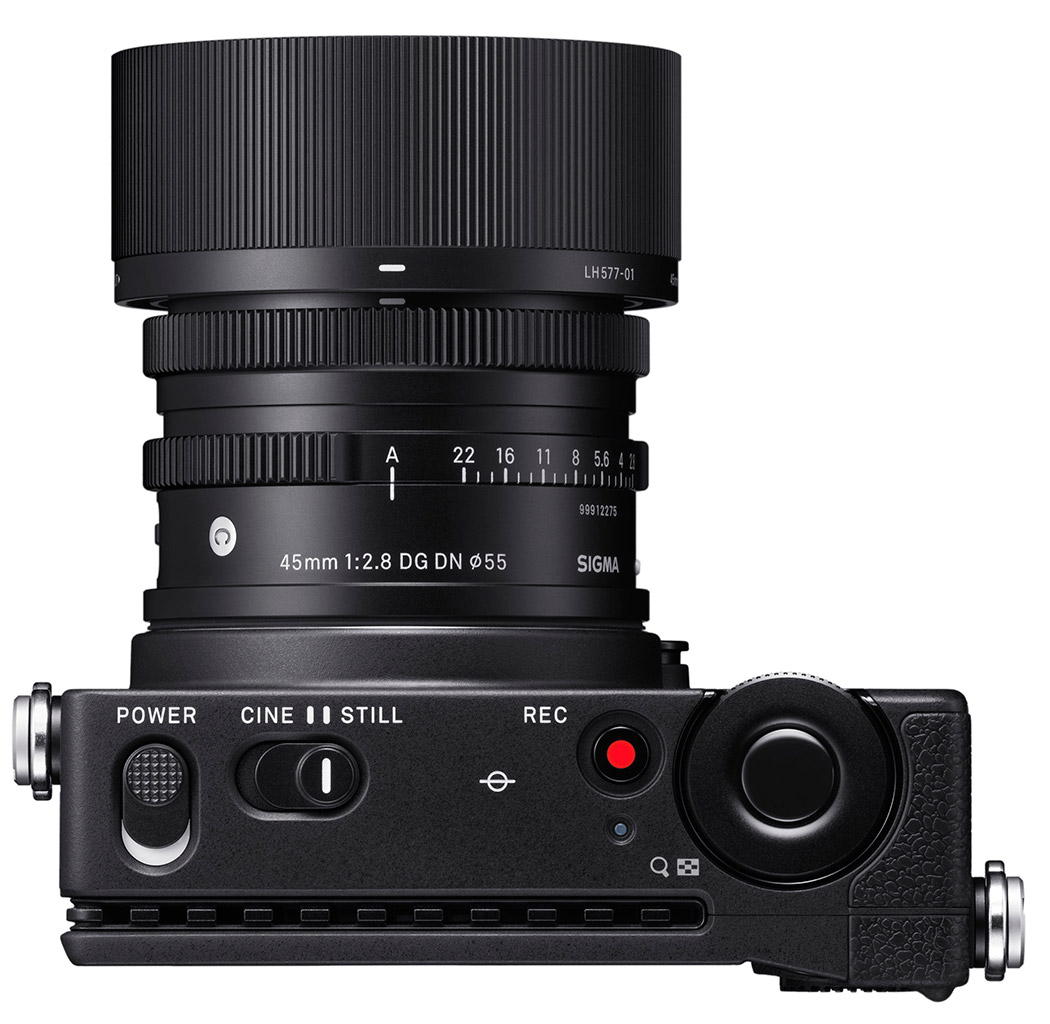
Lorem ipsum dolor sit amet, consectetur adipiscing elit, sed do eiusmod tempor incididunt ut labore et dolore magna aliqua. Ut enim ad minim veniam, quis nostrud exercitation ullamco laboris nisi ut aliquip ex ea commodo consequat. Duis aute irure dolor in reprehenderit in voluptate velit esse cillum dolore eu fugiat nulla pariatur. Excepteur sint occaecat cupidatat non proident, sunt in culpa qui officia deserunt mollit anim id est laborum.
Lorem ipsum dolor sit amet, consectetur adipiscing elit, sed do eiusmod tempor incididunt ut labore et dolore magna aliqua. Ut enim ad minim veniam, quis nostrud exercitation ullamco laboris nisi ut aliquip ex ea commodo consequat. Duis aute irure dolor in reprehenderit in voluptate velit esse cillum dolore eu fugiat nulla pariatur. Excepteur sint occaecat cupidatat non proident, sunt in culpa qui officia deserunt mollit anim id est laborum.
You May Also Enjoy...
Hand’s On: new Sony A9III and Sony 50mm G Master, Sony 85mm G Master, Sony 75-350mm APS lenses
A quick hands on look at Sony A9iii and the Sony APS 75-350mm len
The best wide-angle zoom in the world? The Fujinon G5 20-35mm f4 R WR reviewed.
FUJIFILM GF 20-35mm f/4 R WR L
